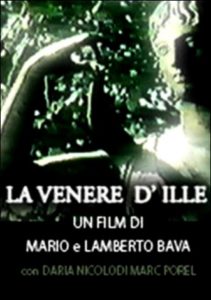 This hour long film, jointly helmed by Mario and Lamberto Bava, is notable as the final directorial credit of the incomparable Mario, and the first for his son Lamberto. It has its moments, but doesn’t approach the elder Bava’s classic films.
This hour long film, jointly helmed by Mario and Lamberto Bava, is notable as the final directorial credit of the incomparable Mario, and the first for his son Lamberto. It has its moments, but doesn’t approach the elder Bava’s classic films.
This film was made for an Italian miniseries called I GIOCHI DEL DIAVOLO (THE DEVIL’S GAMES), consisting of six hour-long films by different directors, all based on 19th Century horror stories selected by the renowned Italian fantasist Italo Calvino. LA VENERE D’ILLE (THE VENUS OF ILLE), lensed in 1979 but not aired until 1981, appears to be the only episode of the series that anyone remembers.
The source tale here was “Venus d’Ille,” Prosper Merimee’s 1835 story about a living statue doing scary things, which was the source of several films over the years, including a 1922 Austrian silent and a 1969 Polish TV adaptation by director Janusz Majewski.
In the woods bordering the estate of the fabulously wealthy Mr. De Peyhorrade a bronze statue of a beautiful woman is unearthed. From the start the statue proves quite troublesome, falling over and breaking a man’s leg. The strapping young antique expert Matthew is summoned to examine the statue, which now resides in a garden on De Peyhorrade’s property. Matthew is quite taken with the statue, but even more so with Clara, the bride-to-be of Mr. De Peyhorrade’s son Alfonso.
On the day of the wedding Alfonso impetuously places Clara’s ring on the hand of the statue, and so has to use a substitute during the ceremony. Afterward Alfonso tells Matthew that he attempted to remove the real ring from the statue’s finger only to have the thing come to life and push him away. Matthew decides to investigate the claim, but he’s confronted by Clara in the garden—or more accurately, the statue in the guise of Clara. They kiss, and then “Clara” disappears.
Later that night the real Clara prepares herself for the consummation of her marriage. She’s approached in her bed by Alfonso, or so she thinks…
Is this film up to the absurdly high standards of Mario Bava’s past accomplishments? No. It does, however, contain a fair amount of Bava’s trademarked visual bravura, particularly a wicked focus pull from a wide shot of Matthew to a close-up of Clara’s eyes, enhanced by the type of gorgeous lighting that only Mario Bava could have pulled off. The climactic stalking of Clara in her bedroom is equally impressive, and likewise enhanced by Bava’s delectable multi-hued illumination.
In common with the Merimee text, the proceedings are kept low key and resolutely non-aggressive. The expected moving statue effects are nowhere to be found, with the climactic stalking conveyed entirely through a lengthy POV shot; as for the subsequent killing, it occurs entirely off-screen. Beyond those things the film is quite talky and uneventful.
This doesn’t make for an entirely uninteresting film—Daria Nicolodi, at least, is quite enchanting as Clara—but does make for one that’s noteworthy solely as the final effort of a master (and the first of his talented son).
Vital Statistics
LA VENERE D’ILLE
Rai 2
Directors: Mario & Lamberto Bava
Producer: Franca Franco
Screenplay: Lamberto Bava, Cesare Garboli
(Based on a story by Prosper Merimee)
Cinematography: Sebastiano Celeste
Editing: Fernanda Papa
Cast: Daria Nicolodi, Marc Porel, Fausto Di Bella, Adriana Innocenti, Diana De Curtis, Francesco DI Federico, Mario Maranzana
